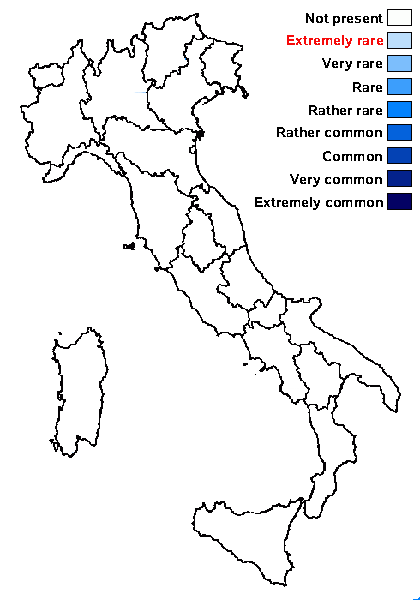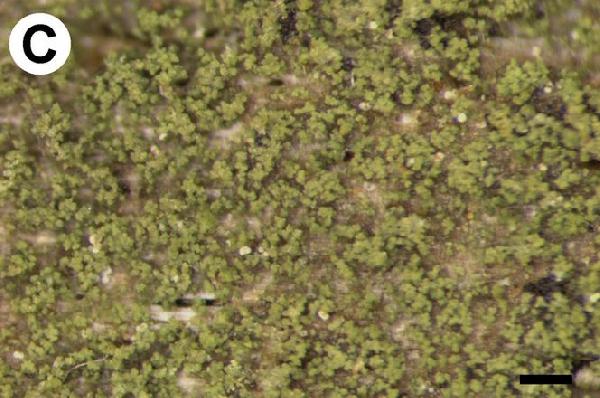Micarea isidioprasina van den Boom, Guzow-Krzem., Sérus. & Kukwa
in Guzow-Krzemińska & al., MycoKeys, 57: 18, 2019.
Synonyms:
Distribution:
Description: Thallus crustose, granular-isidiate, episubstratic to rarely endosubstratic in non-isidiate parts and then appearing as a thin greenish film, sometimes minutely areolate, isidiate, without a distinct prothallus, the areoles up to 0.05 mm wide, green, soon developing abundantly branched and coralloid, crowded, up to 250 µm tall and 25 µm wide isidia forming an almost continuous layer; inner part of isidia with crystals soluble in K, visible under polarized light. Apothecia rare, micareoid, emarginate, white to beige, some patchily grey, up to 0.45 mm across, convex. Proper exciple poorly developed, usually indistinct, appearing as a narrow, colourless zone, the hyphae radiating, branched and anastomosing; epithecium colourless, K-; hymenium colourless, up to 50 µm high, with sparse crystals soluble in K, visible under polarized light; paraphyses branched and anastomosing in upper part, 1-1.5 µm thick; hypothecium colourless. Asci 8-spored, cylindrical-clavate, in K/I with a blue outer layer and apical dome and unstained wall, the dome with an apical cushion, 30-45 x 12-15 µm. Ascospores simple or 1-septate, ovoid, ellipsoid or oblong, 11-14 x 3.5-4.5 µm. Photobiont chlorococcoid, micareoid, the cells 4-7 µm wide. Spot tests: thallus K- or K+ faintly violet, C-, KC-, P-. Chemistry: micareic acid, Sedifolia-grey pigment present in outermost parts of some isidia. Note: a recently-described, isidiate member of the Micarea prasina-complex, growing on wood and acid bark in old, undisturbed forests. The species is hitherto known from a few, scattered localities in Central Europe. To be looked for in Italy.
Growth form: Crustose
Substrata: bark and lignum
Photobiont: green algae other than Trentepohlia
Reproductive strategy: mainly asexual, by isidia, or isidia-like structures (e.g. schizidia)

Predictive model

Source: Svensson, M., Ekman, S., Arup, U., Eide Ekman, L., Hammarström, O., Isaksson, R., Jonsson, F., Palice, Z., Vicente, R. & Westberg, M. 2024. Further additions to the Swedish flora of lichenised fungi. Graphis Scripta 36 (2): 15–49. Oslo. ISSN 2002-4495. - CC BY-4.0
sterile thallus with small, green granules developing into isidia-like structures
(UPS L-1062578). Bar = 1 mm

Source: Guzow-Krzemińska B, Sérusiaux E, van den Boom PPG, Brand AM, Launis A, Łubek A, Kukwa M (2019) Understanding the evolution of phenotypical characters in the Micarea prasina group (Pilocarpaceae) and descriptions of six new species within the group. MycoKeys 57: 1-30. - CC BY-4.0
C M. isidioprasina (holotype) Scale bar: 200 µm
Growth form: Crustose
Substrata: bark and lignum
Photobiont: green algae other than Trentepohlia
Reproductive strategy: mainly asexual, by isidia, or isidia-like structures (e.g. schizidia)

Predictive model

Source: Svensson, M., Ekman, S., Arup, U., Eide Ekman, L., Hammarström, O., Isaksson, R., Jonsson, F., Palice, Z., Vicente, R. & Westberg, M. 2024. Further additions to the Swedish flora of lichenised fungi. Graphis Scripta 36 (2): 15–49. Oslo. ISSN 2002-4495. - CC BY-4.0
sterile thallus with small, green granules developing into isidia-like structures (UPS L-1062578). Bar = 1 mm


